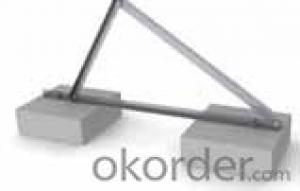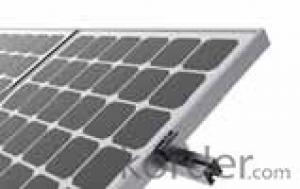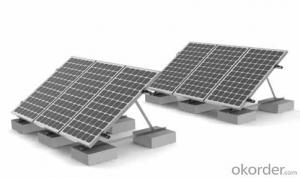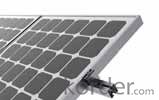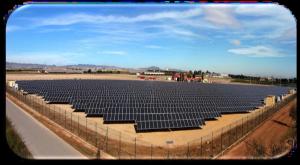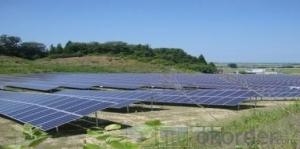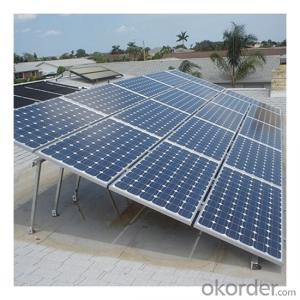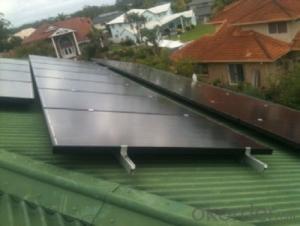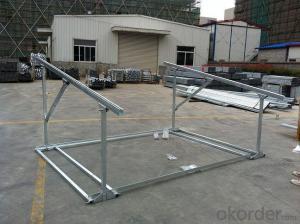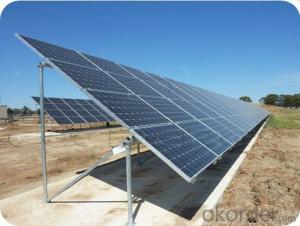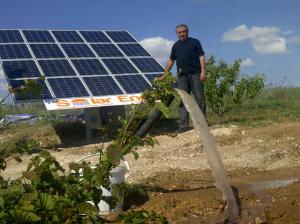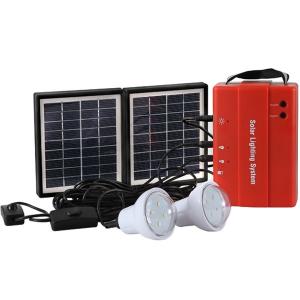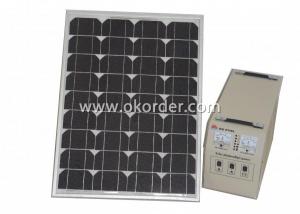Residential Solar Energy Flat Roof System Mounting
- Loading Port:
- China Main Port
- Payment Terms:
- TT OR LC
- Min Order Qty:
- -
- Supply Capability:
- -
OKorder Service Pledge
OKorder Financial Service
You Might Also Like
Product Features
• Adoptable to all kinds of crystalline modules and certain thin film modules.
• Direct foundation bolt , concrete base or bear load are the possible solution for ground installation.
• System installation inclination is adjustable according to requirement.
• Easy installation, only three kinds of tools could finish the installation.
1 Fix the triangular supporting frames
on the concrete base.
2 Fix the rail on the triangular
supporting frames with T-head bolt
and flange nut.
3 Locate the module clamps and put
the PV modules on the rail. Then just
need to fasten the bolt in the clamp.
Flat Roof System
Versolsolar system are being widely used
in all kinds of flat roof according to the
roof bearing capacity and waterproof
requirements. Usually we adopt load
way or chemical anchor bolt to fix the
system on the roof.
Versolsolar chooses high quality material
and good appearance, original design of
connection between al-rail and module
made the installation rapid. No second
processing to the components are
needed on site.
Insrallation site Flat roof
Module specification Frame / frameless module, silicon / film module
Installation inclination Client requirement
Module arrangement Portrait
Module area square Client arrangement
Module area position Client arrangement
Base frame AL 6063T5 / stainless steel
Small pieces Stainless steel, Al6063 T5
- Q: Can solar energy systems be used in areas with limited access to solar energy advocacy groups?
- Yes, solar energy systems can still be used in areas with limited access to solar energy advocacy groups. While the presence of advocacy groups can provide additional resources and support, the feasibility of installing and utilizing solar energy systems depends primarily on the availability and intensity of sunlight in the given area. If the region receives sufficient sunlight, individuals or communities can still adopt solar energy independently, even without the presence of advocacy groups. The use of solar energy systems can help reduce reliance on traditional energy sources, lower electricity costs, and contribute to a more sustainable future.
- Q: How do solar energy systems contribute to reducing carbon emissions?
- Solar energy systems contribute to reducing carbon emissions in several ways. Firstly, solar energy is a renewable and clean source of power. Solar panels harness sunlight and convert it into electricity without any emissions of greenhouse gases. This means that when solar energy is used to generate electricity, it does not release carbon dioxide or any other harmful pollutants into the atmosphere, unlike traditional fossil fuel power plants. Secondly, solar energy can replace the use of fossil fuels in various sectors. For example, solar panels can be installed on residential rooftops to provide electricity for homes, reducing the need for electricity generated from coal or natural gas. Similarly, solar farms can be established to produce large-scale solar power for commercial and industrial purposes. By displacing the use of fossil fuels, solar energy systems help to lower carbon emissions associated with electricity generation. Moreover, solar energy can also be used for heating purposes. Solar thermal systems can capture and utilize the sun's heat to provide hot water for residential and commercial buildings. By utilizing solar thermal systems, the demand for gas or electricity to heat water is reduced, resulting in a decrease in carbon emissions from water heating processes. Furthermore, the widespread adoption of solar energy systems can lead to a decrease in the overall demand for fossil fuels. As more households, businesses, and industries switch to solar power, the demand for coal, oil, and natural gas decreases. This reduced demand for fossil fuels can drive down their production and consumption, resulting in a significant reduction in carbon emissions associated with extracting, refining, and burning these fuels. In summary, solar energy systems contribute to reducing carbon emissions by producing clean and renewable electricity, replacing the use of fossil fuels, reducing the demand for traditional energy sources, and providing an alternative for heating purposes. By transitioning to solar power, we can significantly mitigate the impact of climate change and work towards a more sustainable future.
- Q: How do solar energy systems impact energy reliability?
- Solar energy systems can significantly improve energy reliability by reducing dependence on traditional power grids. These systems generate electricity from sunlight, which is a renewable and abundant source of energy. By diversifying the energy mix, solar energy systems can help minimize the risks of power outages caused by fuel supply disruptions or natural disasters. Additionally, solar panels can be installed on rooftops, enabling decentralized power generation and reducing transmission losses. Overall, solar energy systems enhance energy reliability by providing a stable and sustainable source of electricity.
- Q: Can solar energy systems be used in areas with limited access to sunlight due to shading from nearby buildings or structures?
- Areas with limited access to sunlight due to shading from nearby buildings or structures can still utilize solar energy systems, albeit with potential efficiency implications. It is crucial to evaluate the degree of shading and its impact on the solar panels' electricity generation capabilities. In cases where shading is minimal and temporary, such as when shadows are cast during specific times of the day, solar energy systems can remain feasible. However, if shading persists throughout the day and covers a significant portion of the panels, it can substantially diminish the system's overall energy output. To mitigate the effects of shading, several options are available. One alternative is to optimize the placement of solar panels to maximize exposure to sunlight. This can be achieved by adjusting the panels' tilt angle and orientation or implementing tracking systems that follow the sun's trajectory throughout the day. Another possibility is to employ micro-inverters or power optimizers, which can enhance the output of individual solar panels, even if some are partially shaded. In more extreme shading scenarios, it may be necessary to explore alternative energy solutions or make modifications to nearby structures to minimize shading. This could entail trimming or removing trees, installing reflective surfaces on adjacent buildings to redirect sunlight, or utilizing solar panels on other structures with better access to sunlight. In conclusion, while shading from nearby buildings or structures can reduce the efficiency of solar energy systems, there are still viable options available for areas with limited access to sunlight. It is imperative to assess the specific shading conditions and determine the most suitable solution to maximize energy production.
- Q: How do solar energy systems impact local wildlife?
- Solar energy systems can have both positive and negative impacts on local wildlife. On one hand, these systems do not produce air or water pollution, reducing habitat degradation and improving overall air quality. Additionally, solar panels can provide shade and shelter for certain species. However, the installation of solar farms can lead to habitat loss and fragmentation, affecting the natural movement and breeding patterns of some animals. It is essential to carefully plan and design solar energy systems to minimize these negative effects and protect local wildlife.
- Q: What is the role of grounding systems in a solar energy system?
- Grounding systems are essential in a solar energy system for safety and protection against electrical faults and lightning strikes. The purpose of grounding is to connect electrical equipment and components to the Earth's surface, creating a path with low impedance for electrical faults to flow. This prevents the accumulation of excessive voltages that could be dangerous for both people and equipment. In a solar energy system, grounding serves multiple important functions. Firstly, it ensures protection against electrical shock by redirecting fault currents into the ground, thus minimizing the risk of injury. This is particularly crucial since solar panels and inverters are exposed to sunlight and can be accessed by people during maintenance or repairs. Secondly, grounding helps in dissipating static electricity that might build up in the system, especially in panels and mounting structures. If not properly controlled, static electricity can cause harm to sensitive electronics and even lead to fires or explosions. By grounding these components, static charges are safely discharged into the ground. Furthermore, grounding systems play a critical role in safeguarding the solar energy system from lightning strikes. Lightning carries a tremendous amount of electrical energy, and without adequate grounding, it can cause significant damage to the system. Grounding systems provide a low-resistance path for lightning to follow, guiding the electrical energy safely into the ground. This protects the solar panels, inverters, and other equipment from harm. Lastly, grounding systems help maintain a stable electrical reference point for the system. This is crucial for accurate monitoring, control, and efficient operation of the solar energy system. Grounding minimizes electromagnetic interference (EMI) and noise that can impact the performance of sensitive electronic components, ensuring optimal functioning of the system. In summary, the role of grounding systems in a solar energy system is to prioritize safety by protecting against electrical shocks, dissipating static electricity, and safeguarding against lightning strikes. Additionally, grounding systems maintain a stable electrical reference point, promoting efficient operation and reducing the risk of equipment damage.
- Q: Can solar energy systems be used for waste management?
- Yes, solar energy systems can be used for waste management. Solar energy can power various waste management processes such as waste-to-energy conversion, landfill gas extraction, and waste water treatment. By utilizing solar power, these systems can reduce reliance on traditional energy sources, lower carbon emissions, and contribute to a more sustainable waste management approach.
- Q: Are there any fire safety concerns associated with solar energy systems?
- Yes, there are fire safety concerns associated with solar energy systems. While solar energy systems are generally considered safe and reliable, there have been instances where these systems have caused fires. One potential fire safety concern is related to faulty installation or maintenance of the solar panels. If the panels are not properly installed, there is a risk of electrical faults or short circuits, which can lead to overheating and potentially cause a fire. Similarly, if the system is not regularly inspected and maintained, it can increase the risk of electrical failures and subsequent fires. Another concern is related to the electrical wiring and connections of the solar energy system. Faulty wiring or loose connections can generate heat and may result in electrical fires. This is particularly relevant in older systems where wiring may have deteriorated over time. Moreover, during a fire incident, firefighters may face additional challenges when dealing with buildings equipped with solar energy systems. The presence of live electricity generated by the panels can pose a risk to firefighters, making it more difficult to safely extinguish the fire. To mitigate these fire safety concerns, it is crucial to ensure that solar energy systems are installed by qualified professionals following the necessary codes and regulations. Regular inspections and maintenance should also be conducted to identify and address any potential issues promptly. Additionally, it is important for firefighters to receive proper training on how to handle fires involving solar energy systems to minimize risks.
- Q: How does the cleanliness of solar panels affect their performance?
- The cleanliness of solar panels has a significant impact on their performance. When solar panels are dirty or covered in dust, dirt, or any other debris, it reduces their ability to absorb sunlight efficiently. This results in a decrease in the amount of electricity generated by the panels. Dirt and dust particles on solar panels create a layer that blocks sunlight from reaching the photovoltaic cells. This obstruction prevents the panels from converting sunlight into electricity effectively. As a result, the output of electricity decreases, and the overall performance of the solar panels is affected. Regular cleaning and maintenance of solar panels are essential to maintaining their optimal performance. By keeping the panels clean, you allow maximum sunlight to reach the cells, ensuring efficient energy conversion and higher electricity production. This is particularly important in areas with high levels of dust, pollen, or other airborne particles. Moreover, dirty solar panels can also lead to additional issues. Accumulated dirt can trap heat on the surface of the panels, causing them to overheat. This can potentially damage the panels and reduce their lifespan. Additionally, if the dirt or debris is not cleaned promptly, it can corrode the surface of the panels or create scratches, further affecting their performance and longevity. To maintain the cleanliness of solar panels, it is recommended to clean them regularly, especially in dusty or polluted environments. This can be done using a soft brush or sponge with water and mild detergent, ensuring not to scratch the surface. In some cases, automated cleaning systems or specialized solar panel cleaning services may be used for larger installations. In conclusion, the cleanliness of solar panels directly affects their performance. By keeping them free of dirt and debris, you can maximize their ability to absorb sunlight, leading to increased electricity production and improved efficiency. Regular cleaning and maintenance are crucial to ensure optimal performance and longevity of solar panels.
- Q: Can a solar energy system be installed on a metal roof?
- Yes, a solar energy system can be installed on a metal roof. In fact, metal roofs are often considered ideal for solar panel installations due to their durability, ease of installation, and compatibility with mounting systems. The metal roof provides a sturdy and secure foundation for the solar panels, allowing for a reliable and long-lasting solar energy system.
Send your message to us
Residential Solar Energy Flat Roof System Mounting
- Loading Port:
- China Main Port
- Payment Terms:
- TT OR LC
- Min Order Qty:
- -
- Supply Capability:
- -
OKorder Service Pledge
OKorder Financial Service
Similar products
Hot products
Hot Searches
Related keywords
